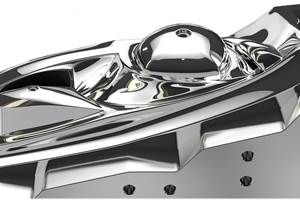Consumer Products:Demands for Thinner Walls/Lightweight Designs Challenging Moldmakers
Recently MoldMaking Technology magazine reached out to its Editorial Advisory Board to examine current trends in the consumer products market and how moldmakers are addressing the challenges.
MMT: What trends are you seeing in the consumer products marketplace?
Dick Laverty, VP, Chicago Mold Engineering (St. Charles, IL): The biggest trend that we see is our customer's desire to make parts with thinner walls to decrease the overall costs of their products.
Tom Lynn, Tooling Engineer, General Electric Appliances and Lighting (Louisville, KY): “I see the consumer industry on a slow recovery, but a lot better than a year ago. Products in some industries are making subtle improvements, rather than a total redesign. Consumers are more careful about making sure they’re getting their bang for their bucks. This trickles down to the moldmaking industries with more hours. Moldmakers and machinists within the trade are starting to move around a bit more. Taking a new job for a few more bucks in the pay envelope is a little easier to do, in that workers feel more confident in our industries’ recoveries.
Ralph Neufarth, Package Development, Procter & Gamble (West Chester, OH): “Obviously with oil prices, cost is a big deal. We are seeing lower costs packages—which means tooling too. Lightweighting for sustainability is strong. Package materials are being made from sustainable materials and the molds must process these efficiently. Finally, more cavities in one mold utilizing rotating cubes, stack molds or a combination of the two.
Michael Zacharias, President, Extreme Tool and Engineering, Inc., (Wakefield, MI): “I see several trends. A lot of our clients are lightweighting their designs. They do this for raw material savings, but also often more importantly for the cycle time savings (which translates into reduced part cost) as a result. Part complexity continues to increase as they combine/eliminate parts; IML and other labeling/decorating has become more widely used; and two-shotting/overmolding is often used. Design/part changes also are frequent, even during—as well as after—a build.
MMT: How is your company addressing these challenges?
Laverty, Chicago Mold Engineering: “For the moldmaker it makes it very challenging to build the molds for the larger parts with the thinner walls and still maintain enough part integrity for strength. It also causes challenges with getting the proper gating on the molds to insure that the parts are full and packed out. This entails doing more finite element analysis to insure the strength of the part and mold flow, mold cool, stress and warp analysis to determine the gating required and whether or not additional flow channeling will be necessary in order to mold the parts with the thinner walls. This is something that we see more and more of every day.
Lynn, GE: Challenges occurring with consumer products in moldmaking would center on the OEM’s need to streamline part design. Some OEMs are combining more parts—making one part from two or even three parts to perhaps increase the cost of the new part. But, comparing that to the total cost of three parts, the new part is less expensive overall. This more complex part means a more expensive mold and more expensive molded part. The trickle-down to the moldmaking industry is that more complex tools means more advanced machining centers and more jobs for moldmakers and machinists. The shops that are making the investment in new equipment are those that will reap the benefits.
Zacharias, Extreme Tool & Engineering: The trend toward lightweighting/thin wall parts bring complexity to molding projects, even when geometry itself is not complex. There are lots of special considerations in molds for thin wall applications.
Part complexity increase is not necessarily an issue, but does drive higher tool costs. It is only an issue when they need cheaper parts and cheaper molds (insufficient tooling budgets). IML and two-shot molds are both widely used and accepted technologies, and are not an issue if the client has sufficient budget for the special molds.
Changes are never easy during a build, but utilization of fully parametric solid design packages is the single biggest tool to enable doing this successfully.
For more information:
Dick Laverty / (630) 584-1311
dlaverty@chicagomold.com / www.chicagomold.com
Tom Lynn/ (502) 452-4193
tom.lynn@ge.com / www.ge.com
Ralph Neufarth / (513) 634-9209
neufarth.re@pg.com / www.pg.com
Mike Zacharias / (906) 229-2510
mike.zacharias@extremetool.com / www.extremetool.com
Related Content
What Is Scientific Maintenance? Part 1
Part one of this three-part series explains how to create a scientific maintenance plan based on a toolroom’s current data collection and usage.
Read More5 Hot Runner Tips for Moldmakers and Molders
Best practices for initial hot runner tryouts and effective preventive maintenance.
Read MoreWhat You Need to Know About Hot Runner Systems and How to Optimize Their Performance
How to make the most out of the hot runner design, function and performance.
Read MoreHow to Achieve the Best Mold Finish
A look at factors that impact the polishability of tool steels and recommendations for obtaining a high-gloss finish.
Read MoreRead Next
How to Use Continuing Education to Remain Competitive in Moldmaking
Continued training helps moldmakers make tooling decisions and properly use the latest cutting tool to efficiently machine high-quality molds.
Read MoreAre You a Moldmaker Considering 3D Printing? Consider the 3D Printing Workshop at NPE2024
Presentations will cover 3D printing for mold tooling, material innovation, product development, bridge production and full-scale, high-volume additive manufacturing.
Read MoreReasons to Use Fiber Lasers for Mold Cleaning
Fiber lasers offer a simplicity, speed, control and portability, minimizing mold cleaning risks.
Read More








.jpg;maxWidth=300;quality=90)









